Riding Mower Buying Guide
These are the 10 best riding mowers based on product quality, customer satisfaction, and price:
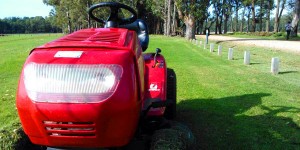 When you are the owner of a large property that has more than a half an acre of grass, taking care of it can be a lot of work.
When you are the owner of a large property that has more than a half an acre of grass, taking care of it can be a lot of work.
Making sure that much grass remains properly irrigated and fertilized are each large tasks in their own right, and preventing weeds or crabgrass from invading your lawn can be a huge headache.
That is why the task of cutting the grass on such a large property should ideally be as little work as possible.
There are a number of ways to do this, but by far the best is to use a riding mower.
Riding mowers are virtually a requirement for property owners who want to keep their lawns well manicured and looking sharp, but who have more than a half an acre to take care of. The idea of cutting so much space with just a small walk-behind lawn mower is pretty much out of the question.
Walk behind mowers just do not have the deck width necessary to finish that kind of job in a reasonable amount of time. Electric walk-behind mowers will either require a half dozen extension cords to reach the far corners of a larger property, or if they are battery powered will not carry enough charge to finish the job.
Gas-powered walk-behind mowers, while they have a somewhat larger deck size than electric walk-behind mowers do, they will still require you to make far too many passes to finish the job efficiently, and will often run out of gas while you are trying to cut larger properties.
Besides that, the chore of maneuvering a walk-behind mower around a property that is more than a half an acre, especially if you are pushing it over uneven terrain or up and down hillier parts of the property, can quickly leave you worn out and sore. Cutting your lawn should never be the kind of job that leaves you exhausted after you are finished, and with the wide variety of riding mowers available on the market today, it does not have to be.
1. Riding Mower is a Good Buyer’s Choice
1a. Riding Ability
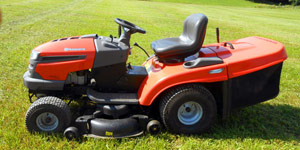 Riding mowers offer numerous advantages to owners of large properties and solve virtually every problem associated with maintaining a lawn that is more than a half an acre large.
Riding mowers offer numerous advantages to owners of large properties and solve virtually every problem associated with maintaining a lawn that is more than a half an acre large.
First of all, as the name makes clear, you do not walk-behind them – you ride them. This in and of itself takes the vast majority of the labor associated with cutting your lawn out of the job in one fell swoop. With a riding mower, cutting your lawn is downright fun.
Who doesn’t enjoy a machine they can ride around their yard? In all seriousness, though, the fact that riding mowers are available is what makes maintaining a large property possible these days. Without them, we would not be able to enjoy a vast expanse of a beautiful, well-kept lawn without hours or even days of difficult labor.
1b. Deck Size
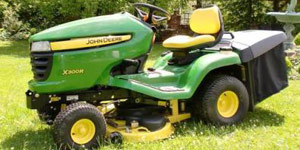 Next, because they have the engine capacity, horsepower and torque necessary to power one or more large cutting blades, they provide deck widths that are significantly larger than walk-behind mowers.
Next, because they have the engine capacity, horsepower and torque necessary to power one or more large cutting blades, they provide deck widths that are significantly larger than walk-behind mowers.
Riding mowers have deck widths that typically begin at around thirty inches and can go as high as fifty or sixty inches on commercial grade riding mowers.
These massive deck sizes significantly reduce the amount of time you will have to spend on mowing your lawn. A larger deck size means you have to make fewer passes to cut your lawn, and fewer passes translates into less time and less labor spent on the job.
A riding mower with a 50 inch deck width could cut a lawn that was a square acre in just fifteen passes, for example. The average walk-behind mower would take more than twice as many passes to do the same job.
1c. Maneuverability
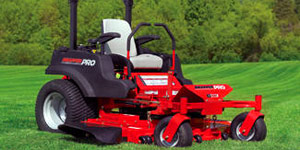 At the same time, it is not always the best idea to go for the largest deck size, even though the amount of power and speed larger machines offer is definitely tempting. But riding mowers with commercial sized deck widths are necessarily more expensive than smaller riding mowers, and unless you own a professional landscaping business, you probably do not need one.
At the same time, it is not always the best idea to go for the largest deck size, even though the amount of power and speed larger machines offer is definitely tempting. But riding mowers with commercial sized deck widths are necessarily more expensive than smaller riding mowers, and unless you own a professional landscaping business, you probably do not need one.
If not, you will most likely be better off with a smaller riding mower, which will still have a significantly larger deck width than walk-behind mowers can even begin to approach.
Smaller deck sizes are also recommended for property owners who have a lot of trees or other obstacles such as closely spaced garden beds on their property.
A very large deck width is not going to be able to maneuver between them, and so owning a riding mower with a huge deck width will be more trouble than it’s worth.
1d. Storage Space
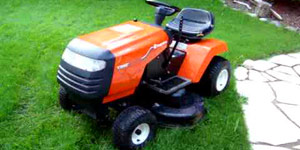 Larger riding mowers often tend to be heavier than smaller ones, and because of this they are also heavier and require a more powerful engine to drive them. More power translates to greater overall ability, but it also means the mower will be more expensive.
Larger riding mowers often tend to be heavier than smaller ones, and because of this they are also heavier and require a more powerful engine to drive them. More power translates to greater overall ability, but it also means the mower will be more expensive.
Beyond that a riding mower with a huge deck width is going to need a lot of storage space. A riding mower with a fifty inch deck width is going to require at least a five foot by six or seven foot storage space.
It is not advisable to store riding mowers outdoors, especially during the winter months, so that means a large mower will require a garage with enough space for it or else a dedicated storage shed. That is something to keep in mind when you are looking at larger riding mowers.
1e. Accessories
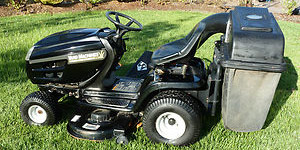 Another advantage that riding mowers have over walk-behind mowers is the wider range of accessories that are available on some models.
Another advantage that riding mowers have over walk-behind mowers is the wider range of accessories that are available on some models.
Riding mowers have the power and size capacity necessary to support accessories such as snow plows and snow blowers, trailer hitches for towing and performing tasks such as removing stumps, leaf collection tools, mulching or bagging options that can deal with very large areas, and spreaders for distributing fertilizer or lawn feed.
Many of these are invaluable to the property owner who has an acre or more to deal with. Leaf collection without a riding mower can be next to impossible on such a large property if you are attempting to do it by hand.
And if you are a serious gardener or have a mini or hobby farm, a riding mower is an incredibly useful machine to have on hand because it can accomplish so many different tasks.
1f. Mowing Needs
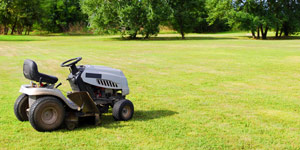 There are a few things you should consider when you are looking to purchase a riding mower. These include the size of your property and how often you intend to mow it.
There are a few things you should consider when you are looking to purchase a riding mower. These include the size of your property and how often you intend to mow it.
Lawn care experts recommend that you do not cut your grass more often than once a week at the very most, and suggest that once every other week is more optimal.
Therefore if you are only using the mower for a small lawn, you will not need to look at commercial or even semi-commercial grade riding mowers. You should also consider whether you need a mower that has the kinds of accessories mentioned above, or if you are simply using it for lawn maintenance.
1g. Engine Size
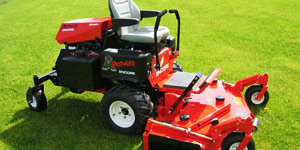 You also will need to consider how much horsepower and torque you want in your engine.
You also will need to consider how much horsepower and torque you want in your engine.
This can be important if you are using the machine for more than just cutting grass, but it also affects its ability to cut reliably through thicker varieties of grass like St. Augustine or Bermuda grass. These are typically grown in the Southern United States and along the Atlantic coast.
And, you should consider how much you are willing to spend on a riding mower, and all of the aforementioned factors will affect the price. Riding mowers can range from several hundred dollars to over five thousand dollars, depending on what they offer.
It will be important to find a balance between what you need from your riding mower and how much you are able to spend on it.
As you can see, there are quite a few advantages to owning a riding mower if you own a large property. Not only can these machines accomplish a diverse array of landscaping tasks, they also take most of the work out of maintaining your lawn. And it goes without saying that they make cutting the grass much more manageable than it would be with a walk-behind mower.
Before you start looking into any of these aspects of a riding mower, however, you will need to understand the two major categories of riding mowers in order to determine which one is best for your needs. Riding mowers fall into one of two types: lawn tractors and zero turn mowers. Each one brings different features to the table, and each one has certain drawbacks compared to the other. Within each group there are a number of sub-categories. These mostly have to do with the size, deck width, and power the mowers offer, and as you might expect, larger, wider, and more powerful mowers are also progressively more expensive.
2. Riding Lawn Mower Types
2a. Garden or Lawn Tractors
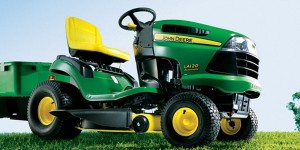 A lawn tractor is just that: a compact tractor that is designed for home and garden use for properties that are more than a half an acre in size. The average lawn tractor is a front wheel drive riding mower with an engine that is between 15 and 25 horsepower. Lawn tractors generally have a deck width that is between thirty and sixty inches, with the average deck width being about 42 inches. This deck width is one of the principal draws that lawn tractors offer, but it is far from the only one. A deck width of about 42 inches means you will have a machine that can easily cut a half an acre of grass or more in well under an hour. But it also means the lawn tractor will not be so large or unwieldy that it will be difficult to maneuver around trees or garden beds or require too much storage space to be practical.
A lawn tractor is just that: a compact tractor that is designed for home and garden use for properties that are more than a half an acre in size. The average lawn tractor is a front wheel drive riding mower with an engine that is between 15 and 25 horsepower. Lawn tractors generally have a deck width that is between thirty and sixty inches, with the average deck width being about 42 inches. This deck width is one of the principal draws that lawn tractors offer, but it is far from the only one. A deck width of about 42 inches means you will have a machine that can easily cut a half an acre of grass or more in well under an hour. But it also means the lawn tractor will not be so large or unwieldy that it will be difficult to maneuver around trees or garden beds or require too much storage space to be practical.
Lawn tractors come in two styles: the traditional lawn tractor, which is designed primarily with grass cutting and lawn care in mind, and the garden style lawn tractor, which is designed with a wider range of landscaping tasks in mind. The traditional lawn tractor will include a few accessories designed to assist with lawn care, such as mulching attachments, leaf collection accessories, extra side bags for collecting grass clippings, and spreaders for distributing fertilizer and lawn feed.
Garden style lawn tractors also typically offer these lawn care accessories, but they also have a number of others. Garden style lawn tractors are the ones that will offer accessories such as snow plows and snow blowers, trailer hitches for towing and pulling out stumps or other debris, and attachments for working the soil. These attachments are designed to till the soil and break it up for double digging at the end or start of the growing season, or for digging furrows in it for planting vegetables. This is particularly useful if you are a serious gardener and have a mini farm in your backyard. A garden style lawn tractor can significantly reduce the amount of labor involved in managing a large vegetable garden.
A lawn tractor takes a lot of the work out of managing the landscaping chores associated with a large property, and can go above and beyond simply cutting the grass. This is a great purchase to consider if you have such a property, especially if you have a large garden or lots of trees on your property and want to significantly reduce the number of hours and amount of work you are putting into maintaining it each year. Elsewhere on this site I provide a more in depth guide to what to look for in a lawn tractor, as well as detailed breakdowns of the specifics for different manufacturers’ lawn tractors that can help you see how different ones stack up against one another.
2b. Zero Turn Mowers
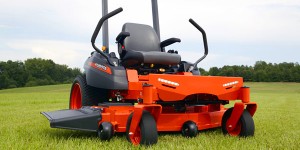 The zero turn mower is an extraordinarily efficient grass cutting tool that offers a rather different set of qualities than the lawn tractor. While zero turn mowers do not have the range of landscaping accessories or towing or plowing capacities that many lawn tractors offer, they are designed to cut lawns very quickly and efficiently, and this is an area in which they are unparalleled.
The zero turn mower is an extraordinarily efficient grass cutting tool that offers a rather different set of qualities than the lawn tractor. While zero turn mowers do not have the range of landscaping accessories or towing or plowing capacities that many lawn tractors offer, they are designed to cut lawns very quickly and efficiently, and this is an area in which they are unparalleled.
Zero turn mowers have a rear wheel drive system that facilitates the tightest possible pivoting, so that the machines are able to do a complete 180 degree turn with ease. The pivot works because the operator is able to provide power differentially to the rear wheels, typically with two levers, each one controlling power to a different wheel. When both wheels are receiving the same amount of power, the zero turn mower moves in a straight line. When one wheel is receiving more power than the other, the mower moves in a curved line. And when one wheel is receiving power when the other is stopped or turning backwards, the mower will pivot on its central axis.
This zero degree axis turning – along with the wide deck size that zero turn mowers boast – means these are the most maneuverable riding mowers on the market today. With a zero turn mower, you never need to worry about overlapping from one row to the next, because you will always be able to turn the mower to exactly the spot you need it. In addition to that, maneuvering around obstacles is much easier with a zero turn mower, because the mower does not need to be moving forward in order to turn. It can literally spin in place. That means you can maneuver it right up to trees and garden beds. This will eliminate the vast majority of the work associated with edging the lawn, which will also go a long way to saving you time in lawn care.
There are four general classes of zero turn mowers. Entry level mowers are the smallest, have the most narrow deck widths, and also are the least expensive. These are perfect for the homeowner who has about a half acre of lawn to care for and who does not cut their grass more than twice a month or so. Entry level mowers are also the least durable, so they are not recommended for larger properties.
Mid grade zero turn mowers are somewhat larger and more powerful than entry level mowers, and their larger deck size is perfect for homeowners who have a property that is more than a half an acre. Semi commercial and commercial zero turn mowers are designed for landscaping professionals. These are the most expensive zero turn mowers, but they also have the widest deck size, are the most powerful, and are the fastest.
As you can see, zero turn mowers convey a particular set of advantages to the homeowner or landscaping professional who is interested solely in cutting grass quickly and efficiently as possible. Elsewhere on this site I provide a more in depth guide to zero turn mowers as well as detailed breakdowns of the specifics for different manufacturers’ zero turn mowers so that you can get a better picture of what to look for when you are shopping for a zero turn mower.
These are the 10 best riding mowers based on product quality, customer satisfaction, and price:











